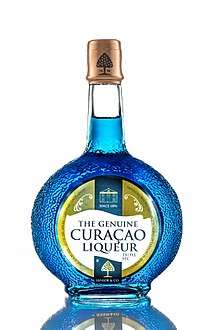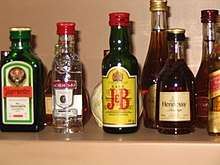Curaçao (liqueur)
 A bottle of Blue Curaçao | |
| Type | Liqueur |
|---|---|
| Manufacturer | (various) |
| Country of origin | Curaçao |
| Introduced | 19th century |
| Alcohol by volume | 15–40% |
| Color | Colorless, but often artificially colored with the most popular being blue and orange |
| Flavor | bitter and sweet orange |
Curaçao (/ˈkjʊərəsaʊ/) is a liqueur flavored with the dried peel of the Laraha citrus fruit, grown on the island of Curaçao.
History
Curaçao liqueur is traditionally made with the dried peels of the "Laraha". Laraha is a bitter orange native to Curaçao with the Latin name Citrus × aurantium subsp. currassuviencis.[1] Spanish explorers brought the bitter Seville orange to the island in 1527, the progenitor of the laraha.[2][3] Although the bitter flesh of the laraha is unpalatable, the peels are pleasantly aromatic.[4]
There are no definitive facts to point out who developed the first Curaçao Liqueur and when. The Lucas Bols distillery, founded in 1575 in Amsterdam, maintains that Lucas Bols (1652–1719) already developed a Laraha-based liqueur. The Dutch West Indies Company had taken possession of Curaçao in 1634 and Bols had shares in both the West and East India Companies to guarantee the cheap supply of spices for their distilled drinks. After the discovery that an aromatic oil could be extracted from the unripe peel of the otherwise useless bitter oranges, Bols had this oil exported back to Amsterdam to develop a liqueur similar to current day Curaçao. Bols tended to add an "element of alchemical mystery" to his products, explaining the unlikely addition of a blue coloring. In 1912 Bols sold blue curaçao as Crème de Ciel ("cream of the sky"), most likely a reference to the 1907 musical Miss Hook of Holland.[5][6]
Senior & Co, a company started in Curaçao, is the only company that has always produced its liqueur from the peels of the Laraha. The Jewish family, Senior and Chumacairo, started selling their liqueur in 1896 in their pharmacy in small quantities. In 1947 they bought the Landhuis (Dutch for "country manor") Chobolobo in Willemstad, where the distillery has since been housed. As this company is the only one that uses laraha fruit from Curaçao, it affects the word "genuine" on its labels.[5][7]
Preparation
To create the liqueur the Laraha peel is dried, bringing out the sweetly fragranced oils. After soaking in a still with alcohol and water for several days, the peel is removed and other spices are added. The company Senior & Co uses a 120-year-old copper kettle for the distilling process. They put the peels in a gunny bag, spices are added and then hung in a heated copper still with 96% pure and kosher alcohol (derived from sugar cane) for 3 days. After 1 day cooling, water is added and distillation takes place for another 3 days.[8] The liqueur has an orange-like flavor with varying degrees of bitterness. It is naturally colorless but is often given artificial coloring, most commonly blue or orange, which confers an exotic appearance to cocktails and other mixed drinks.[9] The blue color is achieved by adding a food colorant, most often E133 Brilliant Blue.[10]
Some other liqueurs are also sold as Curaçaos with different flavors added, such as coffee, chocolate, and rum and raisin.
 A glass of Blue Curaçao liqueur
A glass of Blue Curaçao liqueur- Landhuis Chobolobo: Curaçao Liqueur Distillery
See also
References
| Wikimedia Commons has media related to Blue Curacao. |
- ↑ "Laraha Orange - Senior Liqueur". www.curacaoliqueur.com. Retrieved 2017-07-27.
- ↑ Benjamin, Alan Fredric (2002). Jews of the Dutch Caribbean. Routledge. p. 47. ISBN 0-415-27439-7.
- ↑ "Curaçao Parent Stock - Elemental Mixology". Elemental Mixology. Retrieved 12 November 2017.
- ↑ "Curacao". food.com. 17 August 1999.
- 1 2 Joseph Piercy, Slippery Tipples: A Guide to Weird and Wonderful Spirits & Liqueurs, pp 23-24
- ↑ Bols Blue Curacao Liqueur at Difford's Guide for Discerning Drinkers
- ↑ Curaçao Liqueur history at the Chobolobo distillery website.
- ↑ "Production Process - Senior Liqueur". www.curacaoliqueur.com. Retrieved 2017-07-27.
- ↑ "The Story of Blue Curaçao: Which Is, Strangely, the Other Orange Liqueur — The 9-Bottle Bar". Kitchn.
- ↑ "Webpage about Curacao Liqueur and Triple secs". Archived from the original on May 29, 2013. Retrieved 2012-01-01.


